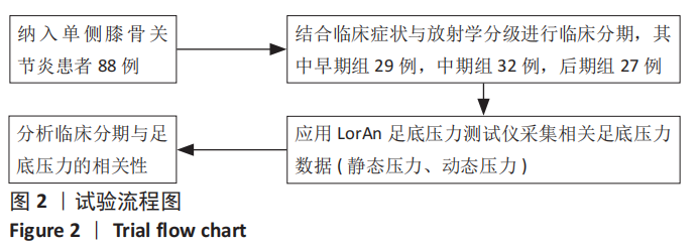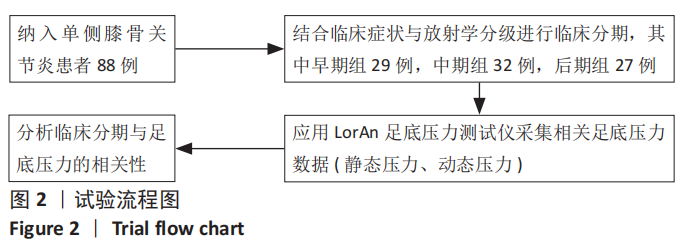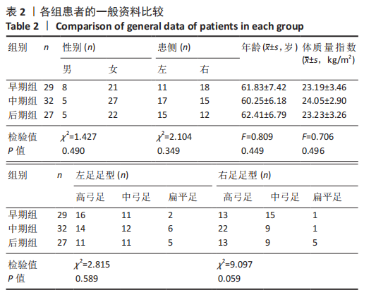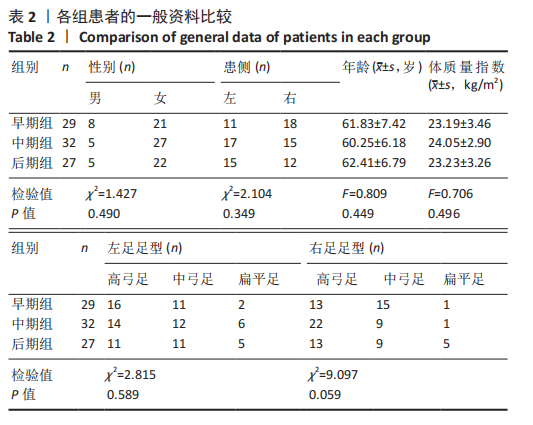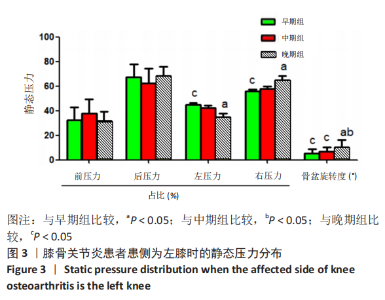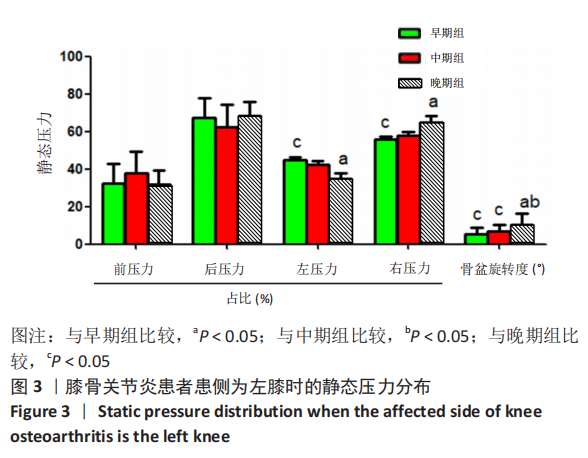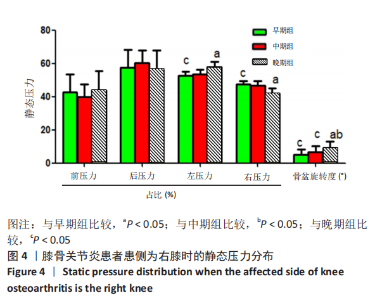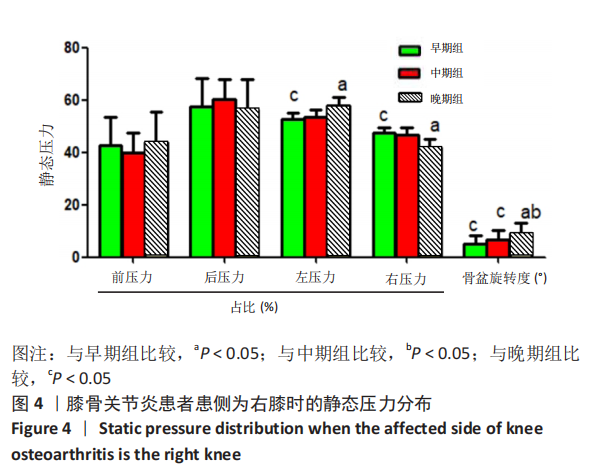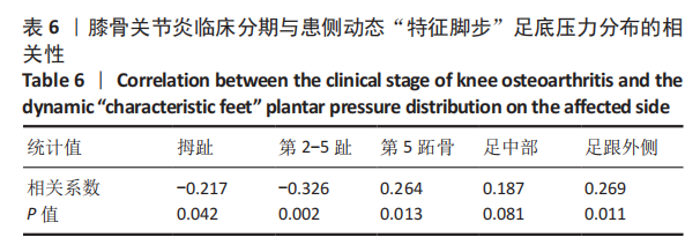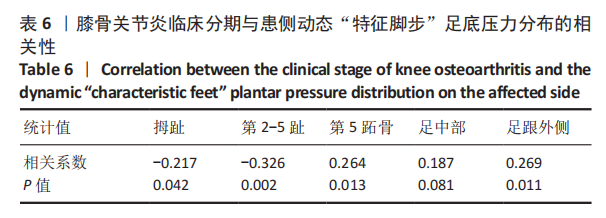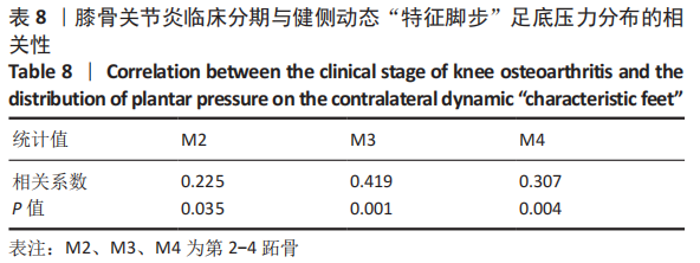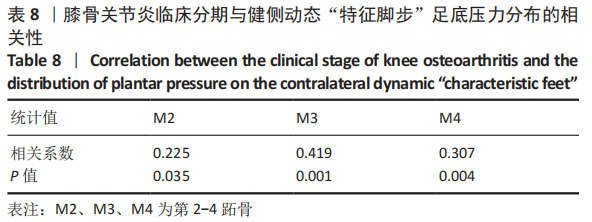[1] 中华医学会骨科学分会关节外科学组.骨关节炎诊疗指南(2018年版)[J].中华骨科杂志,2018,38(12):705-715.
[2] 赵强,张琦,李克文,等.双膝骨性关节炎患者行全膝关节置换术前后足底压力分析[J].现代生物医学进展,2016,16(24):4693-4697.
[3] 高宇,肖强,赵丽莉,等.不同手术方式治疗双膝关节骨性关节炎效果及对足底压力的影响[J].解放军医药杂志,2018,30(2):62-65.
[4] 刘尊瀚. 膝内侧骨性关节炎患者运动学与足底压力分布特点[D].重庆:重庆医科大学,2018.
[5] 夏清,袁海,曹娟娟.膝骨性关节炎患者膝关节疼痛指数与足底压力变化的相关性研究[J].安徽医学,2015,36(11):1358-1360.
[6] 李远栋,刘爱峰,张君涛,等.步态分析在膝关节骨性关节炎中的应用研究进展[J].国际生物医学工程杂志,2020,43(1):75-79.
[7] 潘盛,郑欣,黄超然,等.全膝关节置换术下肢力线的研究进展[J].中国骨与关节损伤杂志,2020,35(8):894-896.
[8] 王欢,王锁良,李峰.膝骨关节炎患者与相匹配的正常人群动静态平衡功能障碍的对比研究[J].西安交通大学学报(医学版),2018, 39(3):414-418+429.
[9] 张永祥,张文洁,邵战海.膝关节骨性关节炎患者足底压力分布规律分析[J].中华临床医师杂志(电子版),2012,6(11):2955-2958.
[10] ORNETTI P, MAILLEFERT JF, LAROCHE D, et al. Gait analysis as a quantifiable outcome measure in hipor knee osteoarthritis A systematic review. Joint Bone Spine. 2010;77(5):421-425.
[11] 张伟强,李具宝,李帆冰,等.踇外翻SCARF截骨矫正术对患侧膝骨性关节炎进展的影响[J].昆明医科大学学报,2017,38(9):100-104.
[12] 翟亚东,熊道海,李长江,等.ICB矫形鞋垫对膝关节骨性关节炎患者平衡能力的疗效[J].中国康复,2017,32(5):428-430.
[13] 邱荣美,王德强.外侧楔形鞋垫对内侧膝骨关节炎下肢关节力学影响的研究进展[J].中国医学工程,2019,27(3):38-43.
[14] 徐晓萍,陈卓铭,杨伟.病态步行姿势纠正训练在女性轻中度膝骨关节炎康复治疗中的应用效果[J].广东医学,2014,35(17):2688-2690.
[15] 中国中西医结合学会骨伤科专业委员会.膝骨关节炎中西医结合诊疗指南[J].中华医学杂志,2018,98(45):3653-3658.
[16] 李静坤,高雅静,石志敏,等.雷火灸联合臭氧疗法治疗膝关节骨性关节炎疗效观察及对血清炎症因子的影响[J].广州中医药大学学报,2020,37(10):1950-1955.
[17] 彭文洁,罗肖,张东,等.本体感觉训练治疗膝关节骨性关节炎的疗效及对患者步态特征和平衡能力的影响[J].临床和实验医学杂志,2020,19(1):102-105.
[18] ORNETTI P, MAILLEFERT JF, LAROCHE D, et al. Gait analysis as a quantifiable outcome measure in hip or knee osteoarthritis: a systematic review. Joint Bone Spine Revue Du Rhumatisme. 2010;77(5): 421-425.
[19] 赵功赫.单侧负重对女性步态生物力学特征的影响[D].北京:北京体育大学,2018.
[20] AL-ZAHRANI KS, BAKHEIT AM. A study of the gait characteristics of patients with chronic osteoarthritis of the knee. Disabil Rehabil. 2002; 24(5):275-280.
[21] KAUFMAN KR, HUGHES C, MORREY BF, et al. Gait characteristics of patients with knee osteoarthritis. Chin J Clin Med. 2014; 34(7):907-915.
[22] ELBAZ A,MOR A,SEGAL G, et al. Novel classification of knee osteoarthritis severity based on spatiotemporal gait analysis. Osteoarthritis Cartilage. 2014;22(3):457-463.
[23] 王子坚,闫松华,李伟,等.单侧膝内翻型膝骨关节炎患者足底压力分布特征研究[J].北京生物医学工程,2019,38(2):151-158.
[24] ARNOLD JB, WONG DX, JONES RK, et al. Lateral Wedge Insoles for Reducing Biomechanical Risk Factors for Medial Knee Osteoarthritis Progression: A Systematic Review and Meta-Analysis. Arthritis Care Res (Hoboken). 2016;68(7):936-951.
[25] HSU WC, JHONG YC, CHEN HL, et al. Immediate and long-term efficacy of laterally-wedged insoles on persons with bilateral medial knee osteoarthritis during walking. Biomed Eng Online. 2015;14:43.
[26] Science; Recent Findings from Hiroshima University Provides New Insights into Gait and Posture Science (Foot alignments influence the effect of knee adduction moment with lateral wedge insoles during gait). Sci Lett. 2016.
[27] CHAPMAN GJ,PARKES MJ,FORSYTHE L, et al. Corrigendum to “Ankle motion influences the external knee adduction moment and may predict who will respond to lateral wedge insoles? An ancillary analysis from the SILK trial” [Osteoarthr Cartil 23 (2015) 1316-1322]. Osteoarthritis Cartilage. 2017;25(4):612.
[28] 王利春,陈华,张洪丽,等.双侧膝骨性关节炎动态足底受力时间分布规律研究[J].中国康复医学杂志,2020,35(8):944-948.
[29] 付焘,于长禾,张洋.等膝骨关节炎临床研究中结局评价指标的应用现况[J].中国医药导报,2018,15(29):21-24,28.
[30] 王喜太.足部矫治原理及实践[M].北京:中国社会出版社,2009.
[31] 郎松,何毓玺,吕波.步态分析在膝关节骨性关节炎诊断中的应用[J].中华中医药学刊,2016,34(10):2427-2430.
|
